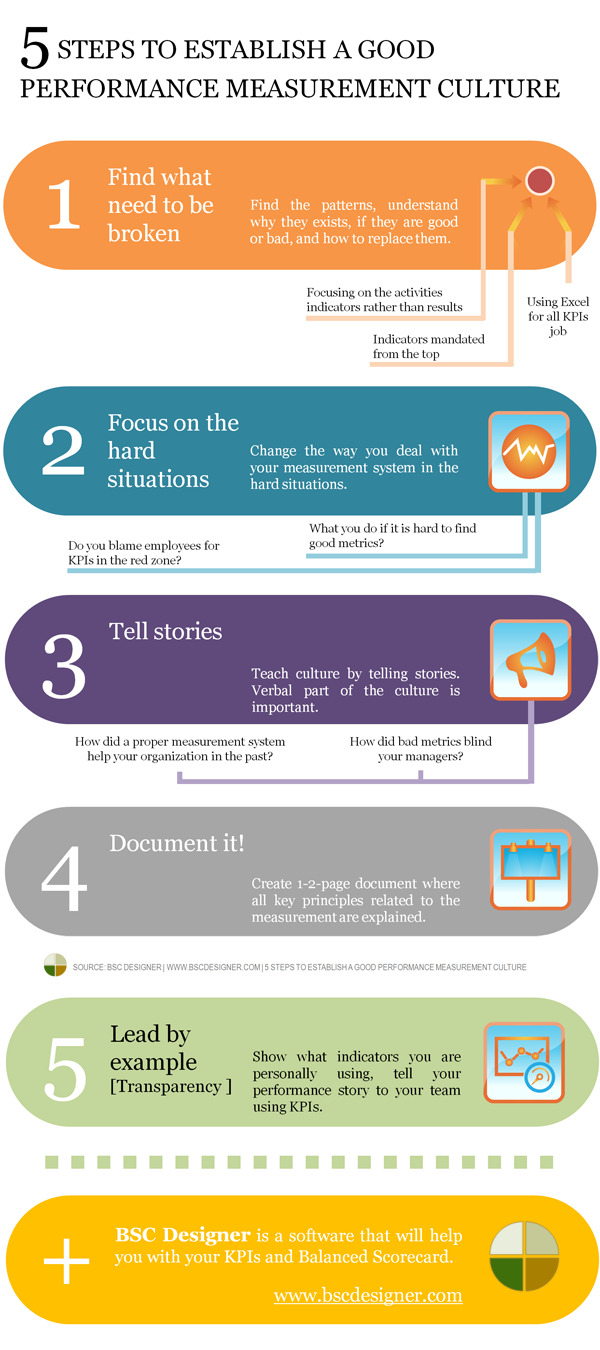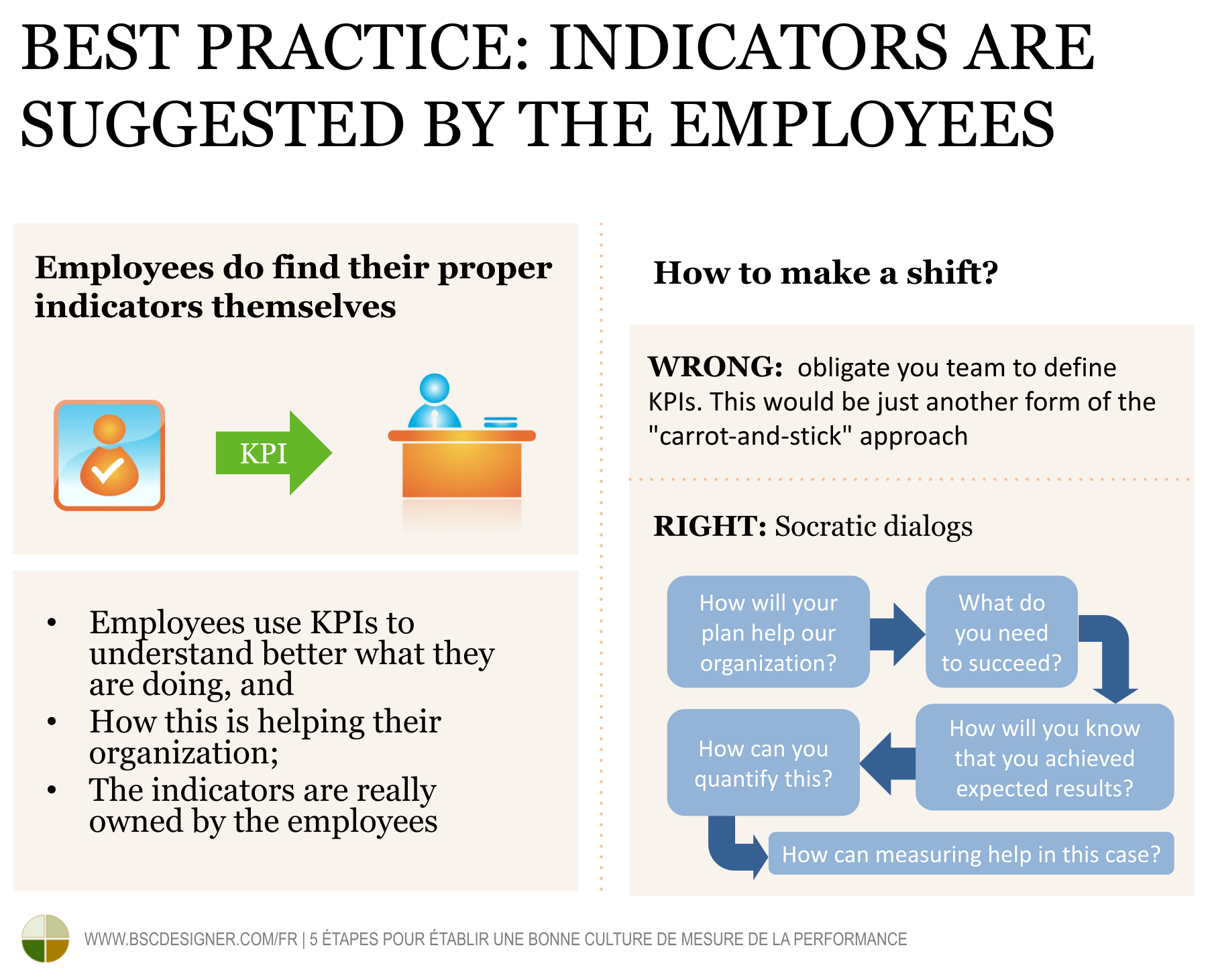An organizational culture consists of the certain behavior patterns that exist in any company. Bad performance measurement practices demotivate a team and induce unproductive behaviors, while better behavior patterns help to involve the team and significantly improve the execution process.

In this article we will talk about:
- What a good performance measurement culture is, and
- How to implement it in an organization.
One doesn’t exist without another, so if you have decided to improve your culture, make sure you are working in both directions.
Performance Measurement Culture
Let’s start with the discussion of what a good performance measurement culture might be.
Bad Managers Use KPIs to Control Employees
A typical “bad practice” is when managers come up with certain metrics and are trying to use them to control their employees. This approach is a technical implementation of a “carrot & stick” management style, which obviously has a very limited usage.

Here are the signs that your organization is at risk:
- The command chain is top to bottom, e.g. you are the person who set KPIs for your team
- You link money rewards to the KPIs (as it was proved in Punished by Rewards, this approach doesn’t work)
- Indicators are inducing unexpected behavior; or simply saying there are the signs of “gaming” indicators by your employees
- KPIs are not updated on time, and finally are abandoned
- Micromanagement using indicators
The questions you might want to ask are:
- How to achieve acceptance of the KPIs?
- How to make my employees accountable?
My answer is that it is not possible in the long-term, unless you shift away from the “carrot & stick” approach.
Best Practice: Indicators are Suggested by the Employees
A different situation: employees are not mandated KPIs top to bottom, but do find their proper indicators themselves. In this case the focus is different. Indicators are not for the “reporting & control,” instead employees use them to understand better what they are doing, and how this is helping their organization.
In this case the indicators are really owned by the employees: they have suggested them, and they will fight for them. They will go the extra mile to make sure that the indicator is updated on time, and it actually reflects what’s going on in the business.
How to Make a Shift?
If on the next meeting you will tell you team that now they are obligated to define KPIs for their projects themselves, don’t expect for anything good to happen. This would be just another form of the “carrot-and-stick” approach. How to do it then?

I believe Socratic dialogs are the best format. Ask your team the right questions and lead them to the idea of a proper measurement system. Here are some questions that you might want to ask:
- What are you going to do to execute this plan and achieve this goal?
- How will it help our organization?
- What do you need to succeed?
- How will you know that you achieved expected results?
- How can you quantify this?
- How can measuring the process/results help us in this case?
Feedback Loop
Make sure that the mentioned Socratic dialog was not a one-time event in your organization. It should be done regularly, as it’s hard to come up with good indicators after the first attempt.
Culture Defines How We Will Act in Hard Situations
Hard situations are the real test for your culture. A quick example: what will happen if some of the indicators are in the red zone? In the companies with a strong performance measurement culture employees know that this is a great opportunity to start asking the right questions:
- What does the new value of the indicator tell us?
- What can we change: a goal, a plan, execute differently, or should we find a better indicator?
Make Your Goals and Plans Measurable “By Design”
One of the exercises that you can regularly practice with your team is trying to understand how the obtained results can be quantified.

Here is a typical process:
- Goal is defined
- Action plan is defined
- Plan is executed
- Results are obtained
Ask your team:
- How can we validate the achieved results?
Very soon you will find that it is much easier to measure something when you care about finding indicators on the first steps. The process now will look like:
- Goal is defined + success factors and indicators are defined
- Action plan is defined
- Plan is executed
- Results are obtained
This approach is still not perfect, as not all goals and action plans are actually measurable. There are always some quantifiable parameters off course, but they can easily generate false positive/negative results, or simply be lost due to insufficient data volumes. An improved version of the process might look like this:
- Goal is defined + success factors and indicators are defined
- Action plan is defined + loop: “Do we need to change something to be able to measure the process and the results?”
- Plan is executed
- Results are obtained
And it’s not about measurement only, it’s about better understanding of the goal and action plan, and finding better ways to execute it.
Example of Making Things Measurable “By Design”
It feels like a good example is needed here. Imagine that I’m doing a training on “Good KPIs / Bad KPIs,” I explained the material, and my students have passed the final test by answering predefined questions.
Sounds good? Not exactly! In this case my approach to measuring things is very superficial. I do have some quantified results, but I can hardly say that these results can justify a company’s investments in the training.
- A better approach is to be proactive, and start preparing the measurement part beforehand.
For the beginning we can have a look at the Kirkpatrick’s Four-Level Training Evaluation Model:
- Level 1. Reaction. Did my students like the training (emotionally)?
- Level 2. Learning. Did they achieved learning objectives that I set?
- Level 3. Behavior. Did their behavior change after the training?
- Level 4. Results. Did their takeaways influence an organization?
Equipped with this model we can prepare a much better performance measurement system for the training, here are just some ideas to implement:
- As one of the first tasks I could ask trainees to write down a list of indicators that they are using now in their business
- After the main part of the training I could ask them to review the list of indicators and analyze what old indicators they want to change and why
My estimation of training effectiveness can be linked to the number of KPI-related insights that students generated during the training. Instead of controlling the knowledge obtained by the test, I could directly check out how the new knowledge is applied.
What about Level 4? Can we measure the performance change in the organization? I think we can! I can ask students to get back to me in 2 weeks and let me know what they have actually implemented in their company. Some additional motivation (like a free eBook) would increase the response rate.
Making Things Measurable “By Design” is not Just About Right Metrics
As the example above demonstrates the “measurement” part is not the most important one, it is more about understanding better how expected goals will be achieved and find better ways to execute an action plan.
How to Implement a New Culture
Here are some ideas to start with:
1. Find What Need to Be Broken first
Analyze your current performance measurement culture, find the patterns, understand why they exists, if they are good or bad, and how to replace them.
Typical bad behavior patterns are:
- Using Excel for all KPIs job and PowerPoint to keep a strategy map
- Indicators mandated from the top
- Aggregating many indicators in one index
- Focusing on the activities indicators rather than results
2. Hard Situations
Pay especial attention to how you deal with your measurement system in the hard situations.
- Do you blame employees for KPIs in the red zone?
- What you do if it is hard to find good metrics?
3. Tell Stories
Teach culture by telling stories:
- How did a proper measurement system help your organization in the past?
- What problems did it help to avoid?
- Why did you decide to move from Excel, what was achieved?
- How did bad metrics blind your managers?
4. Measurement Manifesto
Document it! Verbal part of the culture is important, but a 1-2-page document where all key principles related to the measurement are explained is also important. The format of manifesto works great (check out agile manifesto as an example).
5. Transparency (or Leading by Example)
They say that business needs to be transparent and everyone should see the KPIs/strategy of others. For my opinion the main goal of transparency is not to showcase sensitive data, but to lead by example. Show what indicators you are personally using, tell your performance story to your team using KPIs.
Is it Possible to Measure the Culture?
I guess I cannot avoid this question… It is certainly possible to quantify some aspects of the culture. If you have decided to do this, have a look at these two indicators:
- Culture acceptance rate. A simple survey with 2 or 3 options to choose from will do the job. Do it anonymously if needed. Hopefully you won’t stop after obtaining the numbers: go ahead with the discussion about what need to be changed. A device similar to what we have discussed might be used.
- Turnover rate (among culture carriers). Culture doesn’t exist on the paper, your employees are those who carry and practice it. On the one hand, a high turnover rate might be a sign of losing people that form the organization’s culture, on the other hand, “fresh blood” is a great way to introduce a new culture.
A Final Word
Culture is a long run. Be prepared for a 2-years marathon so you can see the actual results that are all over your organization. Your team will need a long time to change their performance measurement habits, but the best time to start is today. Start with analyzing your current situation, and then go ahead with improving your performance measurement patterns step by step.
What do you like or don’t like about the performance measurement culture in your organization? Feel free to share your thoughts in the comments.
BSC Designer is strategy execution software that enhances strategy formulation and execution through tangible KPIs. Our proprietary strategy implementation system reflects our practical experience in the strategy domain.